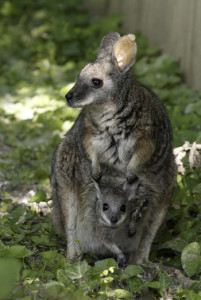WALNUT CREEK, Calif.—Carbon dioxide may be the most name-dropped greenhouse gas, but methane is 20 times more potent. In 2009, the U.S. Environmental Protection Agency calculated that 20 percent of the nation’s human-related methane emissions were attributable to livestock digestive processes. In Australia, livestock emissions account for 12 percent of the country’s total greenhouse gas emissions.
To understand how methane is produced in livestock, an international team of scientists including researchers at Australia’s Commonwealth Scientific and Industrial Research Organisation (CSIRO) and the DOE JGI collaborated to sequence the microbial communities inside the Tammar wallaby, a plant-eating marsupial related to the familiar kangaroo whose digestive system has been compared to that of ruminants such as cows and sheep.
In the June 30, 2011 issue of Science Express, the researchers described the genome of a bacterium found in the wallaby’s gut that could help explain why the methane emissions in these Australian marsupials are lower than those of livestock. The information could be used to reduce the methane emissions contributions of livestock not just in Australia but worldwide.
“We hope that in the next few years, in addition to strategies inhibiting the abundance of methane-producing microbes in livestock, we will have identified how to augment the growth of other bacteria so that feed digestion and fermentation remain optimal and with reduced methane emissions,” said study senior author Mark Morrison, a CSIRO Science Leader in Metagenomics who works in their Division of Livestock Industries. “We think the research with the Tammar wallabies have provided us another group of bacteria to target, in addition to revealing other key differences between livestock and macropodids—marsupials such as kangaroos and wallabies.”
The Tammar wallaby’s gut microbiome was sequenced by the DOE JGI under the 2007 Community Sequencing Program portfolio in part to compare how plant biomass is degraded by the marsupial gut microbiota compared to other gut microbiota, and the results were described in a Proceedings of the National Academy of Sciences USA (PNAS) publication last year. DOE JGI metagenome scientist Susannah Tringe, a co-author on both of the Tammar wallaby papers, called this work “a really clever follow-up,” noting that in the previous study, “[the researchers] observed novel uncultivated bacteria that appeared to be unique to the wallaby gut, including one they named WG-1 (for Wallaby Group 1).”
“This new work builds on the growing knowledge portfolio of DOE JGI gut metagenome projects targeting biomass-degrading organisms, such as the termite hindgut metagenome and the recent cow rumen metagenome [published in Science earlier this year],” Tringe said. In addition to making these datasets publically available, DOE JGI and its collaborators provide computational tools to further enrich the opportunities to explore diverse industrial applications. “The DOE JGI is uniquely positioned, working in concert with our community of collaborators, to apply the power of genomics to important societal issues.”
CSIRO postdoctoral fellow Phillip Pope, Morrison and his colleagues at CSIRO used the DOE JGI’s metagenome assembly to construct a partial draft genome of WG-1 using a binning algorithm known as PhyloPythia, developed by Professor Alice McHardy, from the Max Planck Institute for Informatics in Saarbrücken, Germany.
“With that blueprint in hand, it was possible to use metabolic pathway information to devise a strategy to bring this previously uncultivated ‘bug’ into culture for more in-depth study,” Tringe said.
“Our initial analysis of the metagenomic dataset, first reported in the PNAS article, showed that there were key bacterial and enzyme-based differences between the microbiota present in Tammar wallabies and other herbivores,” said Morrison. “The current Science paper involves our use of computational methods to produce the information needed to isolate [WG-1] and evaluate its potential role in feed digestion and reduced methane emissions,” via further experimentation and complete genome sequencing.
Pope and colleagues propose that WG-1 and this group of bacteria more generally may hold clues for efforts to modify fermentation in livestock so as to produce less methane. “Our multinational collaboration stems from support provided by the DOE JGI Community Sequencing Project. It has not only been a key for us to better understand the microbial aspects of plant digestion by the Tammar wallaby, but has also furthered our knowledge of the microbial world and its roles in energy production,” said Morrison.
The U.S. Department of Energy Joint Genome Institute, supported by the DOE Office of Science, is committed to advancing genomics in support of DOE missions related to clean energy generation and environmental characterization and cleanup. DOE JGI, headquartered in Walnut Creek, Calif., provides integrated high-throughput sequencing and computational analysis that enable systems-based scientific approaches to these challenges. Follow DOE JGI on Twitter.
